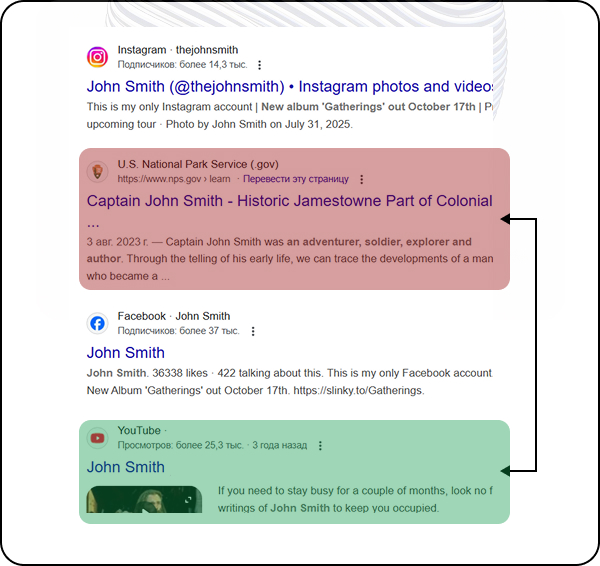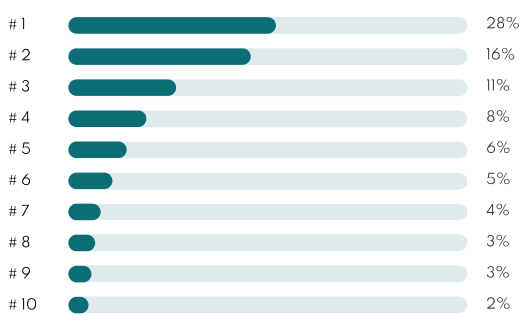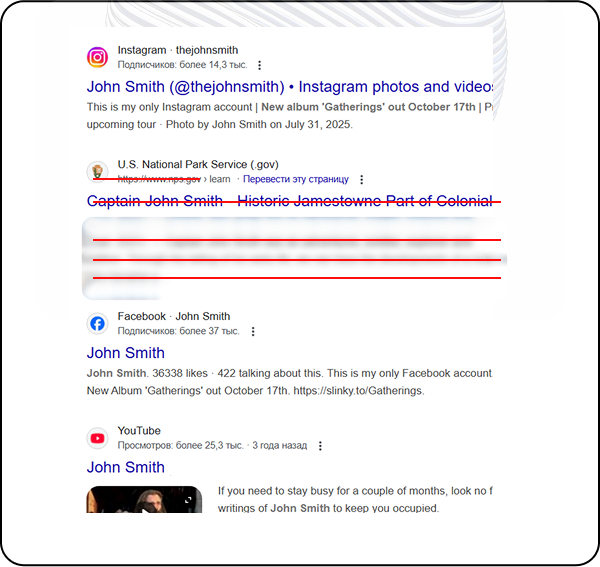We guarantee 100% confidentiality
WHAT WE DO?
Control Search Results
Take charge of your online reputation. Using cutting-edge software, our in-house SEO experts, professional writers, legal tools, and advanced algorithm knowledge, we can craft a plan to promote the content you want visible while pushing negative content off the first page.
-
The average Google Search session is just under 1 minute. This means that within 1 minute the average user has already made
-
Up to 72% of people will make a decision to avoid you upon finding negative content online; and
-
88% of consumers trust online content as much as a personal recommendation.

Google Orgranic CTR Breakdown by Position
If bad press ranks in the first few positions of Google for your brand or name, it's a major problem because most users never scroll past the first few results—and click-through rate (CTR) becomes a key signal that can either help bury the bad press or make it stick longer.


| Option | Effectiveness | Cost |
| #1.Waiting For Negative Articles To Naturally Fall Off The First Page | Low | Free |
| #2.Submit a DMCA (Digital Millennium Copyright Act) Takedown Notice on Google | Low | Free |
| #3. Hire an SEO Expert⭐️Ross Kernez⭐️to Clean Your Name or Brand | High | $$ |
| #4. Reaching Out To Journalists to Take Down Content from Google Search | Low | Free |
| #5. Explore Legal Strategies to Take Down Negative Content Online | Medium | $$$ |
| #6. Requesting an Update To a Negative Article Via Email Outreach | Low | Free |
| #7. Create Social Media Profiles | Medium | Free |
| #8. Create New Websites | Medium | $$ |
| #9. Become a Writing Contributor | Medium | $ |
| #10. Create Backlinks & Digital PR | Medium | $$ |
Relying on the freshness algorithm, also known as the Freshness Systems, to let negative articles naturally fall off the first page of search results is often not a viable strategy for managing your online reputation, especially if you want to take down negative results from Google quickly. Search engines like Google prioritize newer content, and if negative content continues to generate clicks, shares, or backlinks, it may maintain its ranking regardless of its age. Therefore, depending solely on the freshness algorithm is risky and can leave your reputation vulnerable for an extended period.
Hiring an experienced reputation expert specializing in online reputation management can expedite this process by actively working to displace negative content with positive, relevant information. An expert can ensure that any new negative content is swiftly addressed and managed. They can implement strategies to prevent negative articles from gaining traction, such as monitoring your online presence, responding to negative feedback appropriately, and continually updating and optimizing positive content.
To submit a DMCA (Digital Millennium Copyright Act) takedown notice to Google, you must follow a formal process. Begin by identifying the infringing content and locating the URLs of the specific pages containing the infringing material. Gather evidence that proves the content infringes on your copyright.
Next, submit the notice to Google by visiting Google’s DMCA page at https://support.google.com/legal/troubleshooter/1114905. Select the appropriate product (e.g., Search, YouTube) and follow the prompts to fill out and submit the form.
After submitting, monitor the process, as Google will review the notice and may contact you for additional information. If the notice is found valid, Google will take down the infringing content from their search results.

An experienced SEO expert like Ross Kernez employs advanced suppression techniques that he developed over years to influence search engine results, utilizing positive news content, creating new websites, publishing favorable press and leveraging social media presence to suppress negative results on Google. He will develop a custom strategy tailored to your specific needs, ensuring that positive stories about you or your business are prominently displayed in search results. By improving the visibility of favorable content, he can effectively suppress negative search results.
Journalists value truth; your role is to help them see how that truth has evolved. A results‑driven Search Engine Suppression Service frames outreach around accuracy, not blame, to Suppress Negative Search Results. Locate the writer, gather their preferred contact details, and open with appreciation for their work. Provide fresh data, corrections, or legal clarifications that demonstrate why the piece no longer reflects reality and politely invite an edit or takedown.
Thinking about suing for defamation to clean up search results? Proceed with caution. Lawsuits drain budgets, stretch on for ages, and can backfire spectacularly—drawing more eyeballs to the very piece you want gone. Media outlets love covering legal drama, and win or lose, the story often outranks the original article. Plus, proving falsehood and malice is a steep hill to climb. Rather than betting on a courtroom win, channel your time and funds into search‑suppression strategies that quietly push the negative page out of sight.
Article‑update requests work best when they feel like collaboration, not combat. A reputable Search Engine Suppression Service approaches journalists with courtesy, rock‑solid facts, and zero hint of censorship. Start by thanking the writer for their coverage, then share fresh data or documents that correct outdated or unbalanced points. When the reporter sees that the update enhances accuracy—not just your image—they’re far more likely to revise, reducing the article’s prominence in search results without a fight.
Your social profiles are protective armor for your reputation. Secure your name on major networks, polish the bios with keyword‑rich messaging, and post consistently. Because Google loves fresh, authoritative content, those profiles leap to the top—diminishing the visibility of unflattering articles while building trust through direct, authentic interaction.
Your own website is a digital home base: authoritative, searchable, and 100% yours. By publishing keyword‑rich content—case studies, thought leadership, success stories—you give Google fresh, credible pages to rank above skeptical blog posts or old news. Visitors get the real you, and negativity fades into the background.
Turn your hard‑won insights into reputation armor. Pitch guest posts to respected publications, share practical wisdom, and watch Google reward you with prominent rankings. Every new byline adds trust signals, expands your professional network, and quietly crowds out outdated or unfavorable content—no flashy PR stunts required.
Think of backlinks and digital PR as reputation jet fuel. When respected sites link to you—and journalists quote you—search engines read those signals as “credible, trustworthy, valuable.” That credibility lifts your pages above old controversies, flooding results with positive coverage and solidifying your brand’s authority.
What is search‑engine suppression, and how does it differ from traditional SEO?
Google suppression service is a reputation‑focused strategy that intentionally pushes unwanted or harmful pages down the results page so they become virtually invisible to searchers. Traditional SEO, by contrast, is designed to lift a brand’s own pages higher, but it does not deal directly with detractors. Suppression campaigns combine defensive tactics—creating, optimizing, and promoting positive or neutral content—with legal and technical measures where appropriate. The goal is not simply better ranking for your site, but strategic displacement of negative content that occupies valuable top‑10 positions. Put another way, SEO builds; suppression shields.
How does your suppression service actually work behind the scenes?
We start with a forensic audit of every ranking URL, backlink profile, and social signal connected to the negative result. Next, we map searcher intent to determine what fresh assets—articles, press releases, video, social posts, or microsites—should be launched to outrank the offending links. Each asset is optimized for authority through targeted outreach, digital PR, and contextual link‑building that complies with Google quality guidelines. Concurrently, we deploy technical tactics such as schema markup, structured data, and entity stacking to widen the semantic gap between your brand and the harmful content. The process is iterative and data‑driven, with weekly adjustments until the negative link loses visibility.
Can you completely remove negative content from Google?
Permanent removal is possible only when the content violates a law or a platform’s terms of service—examples include defamation, copyright infringement, or doxxing. In those cases we coordinate takedown requests, DMCA filings, and, if needed, legal counsel. When a page is merely unflattering yet lawful, outright deletion is unlikely, so suppression becomes the ethical and reliable alternative. By overwhelming Google’s relevance signals with stronger, more current assets, we push the harmful result to pages two, three, or beyond. In most user journeys, anything past the first page effectively disappears.
How long does it take to push down negative search results?
Timeframes depend on the authority of the offending site, the keyword’s competition level, and how many positive assets already exist. A local news article about a private individual may drop in four to six weeks, whereas a national publication covering a public company could take six to nine months. We provide a projected timeline after the initial audit so you know exactly what to expect. Throughout the campaign we track rank movement daily and share transparent progress reports. Consistency and iterative optimization are key to accelerating results.
Will the suppressed results come back after the service ends?
Once a negative link is buried, it usually stays buried provided the newly created positive ecosystem remains active. However, Google’s algorithm evolves, and dormant assets can lose authority over time. That’s why we recommend a light maintenance plan involving fresh content generation and periodic link audits. Think of suppression as both a sprint to fix an urgent problem and a marathon to safeguard your reputation long term. With ongoing monitoring, resurgent negative links can be re‑suppressed before they regain traction.
Is search‑engine suppression legal and compliant with Google policies?
Yes. Our methodology aligns with Google’s Webmaster Guidelines and avoids black‑hat tactics such as link farms or cloaking. We focus on factual, value‑adding content, transparent outreach, and ethical optimization techniques. When legal remedies are available, we follow due process rather than exploit loopholes. Because we work within policy frameworks, clients avoid penalties and enjoy durable gains. The approach is reputation‑first and risk‑averse.
What kinds of negative content can be suppressed?
Typical targets include unfavorable news stories, negative reviews, forum threads, outdated court dockets, and personal blog posts that cast you in a poor light. We can also tackle cached pages, image results, and YouTube videos associated with damaging keywords. Each content type requires a tailored suppression blueprint—videos often need engagement‑driven counter‑videos, while text pieces benefit from long‑form authoritative articles. Even auto‑suggest terms and related‑search boxes can be influenced with sustained effort. The guiding principle is to replace or outrank every unhelpful asset a searcher might see.
How do you measure the success of a suppression campaign?
We define key performance indicators (KPIs) at kickoff, typically focusing on the rank position of each negative URL and the combined share of voice for your controlled assets. Progress is tracked using enterprise‑grade SERP monitoring tools, corroborated by manual checks in incognito mode across multiple locations. When the harmful link drops beyond position 30 (page 3), we consider that issue resolved, but we continue to watch for volatility. Secondary metrics—click‑through rates to your owned properties, sentiment analysis, and backlink growth—add deeper insight. All data is shared in interactive dashboards with weekly commentary.
Do I need to provide any information or materials to start?
Your input accelerates results, but the workload rests on us. We ask for brand guidelines, approved messaging, and any existing creative assets we can leverage—logos, images, or articles. If legal claims are involved, supporting documents expedite takedown routes. Access to your owned digital properties (blog, social profiles, YouTube channel) allows us to publish quickly under authoritative domains. Beyond that, you can be as hands‑off or hands‑on as you like; our team handles research, content, and outreach.
Will suppression harm my existing positive rankings?
No—our strategies enhance overall domain authority, which benefits your legitimate pages. Because we build rather than break links, your site’s health metrics (Core Web Vitals, spam score, trust flow) remain intact or improve. We isolate suppression assets under separate subdomains or third‑party platforms when needed to avoid cannibalization. Comprehensive keyword mapping ensures new content doesn’t compete with your money pages. The result is a stronger, more resilient search presence.
What if the negative information is true but outdated or lacks context?
Even factual content can be unfairly damaging if it’s old, incomplete, or one‑sided. In such cases we emphasize context and recency by publishing authoritative updates, case studies, or testimonials. This balanced approach shifts user perception without denying reality. Where transparency helps, we incorporate your official statement to demonstrate accountability. Search engines reward fresh, comprehensive coverage, which in turn demotes stale negativity.
How is pricing determined for Google suppression services?
Fees depend on severity and scope: number of keywords, authority of negative domains, geographic reach, and desired timeframe. A single‑keyword personal campaign might start in the low four figures per month, whereas a multi‑keyword corporate engagement could reach high four to five figures. We itemize deliverables—content volume, outreach hours, legal filings—so you see exactly what you’re investing in. Retainers are structured to align incentives: milestones link payment to measurable rank movement. Custom quotes follow the initial diagnostic report.
Is ongoing maintenance required after the initial suppression?
We recommend a scaled‑down maintenance phase once core goals are met. Monthly check‑ups catch algorithm shifts, new negative content, or competitor activity that could undo progress. Maintenance typically involves content refreshes, backlink hygiene, and sentiment monitoring. The cost is a fraction of the primary campaign because the heavy lifting is complete. Think of it as an insurance policy for your digital reputation.
Can this service help during an active PR crisis?
Absolutely. Suppression can be combined with real‑time digital PR to address immediate fallout. We fast‑track content creation, coordinate with your communication team for consistent messaging, and amplify positive news through high‑authority publications. While PR shapes the narrative, suppression controls what surfaces when stakeholders Google you, minimizing the lifespan of damaging stories. Together they form a comprehensive crisis‑response framework.
Does suppression work on international search engines and in multiple languages?
Yes. We localize content and outreach for each target market, accounting for regional ranking factors on Google, Bing, Baidu, Naver, or Yandex. Native‑language writers craft culturally appropriate assets, while international link partners supply geographic relevance. Technical tweaks—such as hreflang tags—ensure proper indexing across locales. This multi‑layered effort delivers consistent reputation control worldwide. Clients with global footprints especially benefit from unified brand perception.
How is your service different from DIY reputation management software?
Most software platforms automate alerts and suggest content ideas but leave execution to you. Our service is hands‑on and outcome‑oriented: strategists, writers, PR specialists, and legal experts work in concert. We shoulder the heavy operational burden—content creation, publisher negotiations, and ongoing optimization—so you can focus on business. DIY tools are useful adjuncts, and we integrate their data when beneficial. Ultimately, suppression success hinges on expertise and human relationships that software alone can’t replicate.
What safeguards are in place to protect my privacy and data?
We operate under strict confidentiality agreements and limit project access to need‑to‑know team members. All data is stored in encrypted environments that exceed industry compliance standards. We never disclose client identities to publishers without explicit consent. Regular audits and penetration testing keep our infrastructure resilient. Your reputation project remains discreet from start to finish.
Who typically benefits most from search‑engine suppression?
High‑profile individuals, executives, physicians, attorneys, and brands in regulated industries are frequent clients because a single negative link can cost millions in lost trust. Small business owners facing competitive smear campaigns also see rapid ROI. Job seekers with outdated college indiscretions or litigants with dismissed lawsuits gain clean slates for future opportunities. Even nonprofits and public figures rely on suppression to maintain donor confidence. In short, anyone whose livelihood hinges on first impressions can benefit.
How quickly can you begin, and what does onboarding involve?
We can commence within three business days once the contract and initial retainer are in place. Onboarding starts with a 90‑minute strategy call to clarify goals, key messages, and sensitivities. Next, our research team performs the deep‑dive audit and drafts a campaign roadmap within one week. Content creation and outreach then proceed in parallel sprints, with the first positive assets typically going live in week two. You receive a dedicated project portal with real‑time status updates from day one.
What guarantees do you offer, and what expectations should I have?
Because search algorithms are outside any provider’s control, ethical firms cannot promise specific rank positions by exact dates. Instead, we guarantee the scope and cadence of deliverables, transparency in reporting, and a commitment to work without extra charge until agreed‑upon visibility thresholds are reached. Success for most clients means all negative links are pushed to page three or lower for each target keyword. If unforeseen obstacles arise—such as new litigation or media coverage—we revisit strategy collaboratively. Our 92% success rate underscores both realistic planning and relentless execution.

